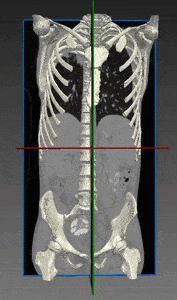
Bone segmentation in orthopedic surgery
Incorporation of new visualization technologies and planning methodologies shortens examination, planning and operation procedures in orthopedic surgery, while retaining the high standard of accuracy that are required in these common practices. Innovative algorithmic techniques, relying on image processing, computer vision and machine learning are increasingly utilized and have gained approval by regulatory bodies such as the FDA, leading to what is better known as Computer Assisted Orthopedic Surgery (CAOS) procedures. This requires accurate bone segmentation, better performed using the method which we recommend.
Read More

Detection and quantification of bone cancer
Metastatic bone malignancies arise following prostate cancer (80% of cases, with 3% five-year survival rate), breast cancer (with no cure) or lung cancers (with 11% two-year survival rate). Bone metastases affect more than 400,000 people annually in the United States with frequent occurrences among patients undergoing irradiation and secondary effect to other treatments. Detection of skeletal metastases has a major impact on devising treatment strategies and prognosis. The solution offered by RSIP Vision produces 3D surfaces of bones and other skeletal-related structures to detect and quantify primary and metastatic bone cancer.
Read More

Point and surface registration in orthopedics
Point and surface registration enable computer vision and image processing to improve surgical orthopedy practices and affect surgery outcome recovery. Bringing point and surface registration in the field of orthopedics, computer vision and image processing hold the potential to improve surgical practices and affect surgery outcome to favor the benefit of patients and fast recovery. Measurement accuracy (within less than 1 mm) is a strict constraint to computer-vision-based algorithms.
Read More

Bones and Skeleton segmentation
RSIP Vision suggests an automatic segmentation procedure based on iterative binarization of bone tissues density, as observed in Computed Tomography (CT), the most common 3D process used for bone imaging. This method is particularly fast, regardless of whether contrast was used in the CT scans. In fact, images taken with contrast generally display blood with an intensity which is similar to bone; our technique is able to overcome this challenge and to deliver a fast and satisfying bones segmentation and skeleton segmentation solution to our client.
Read More
